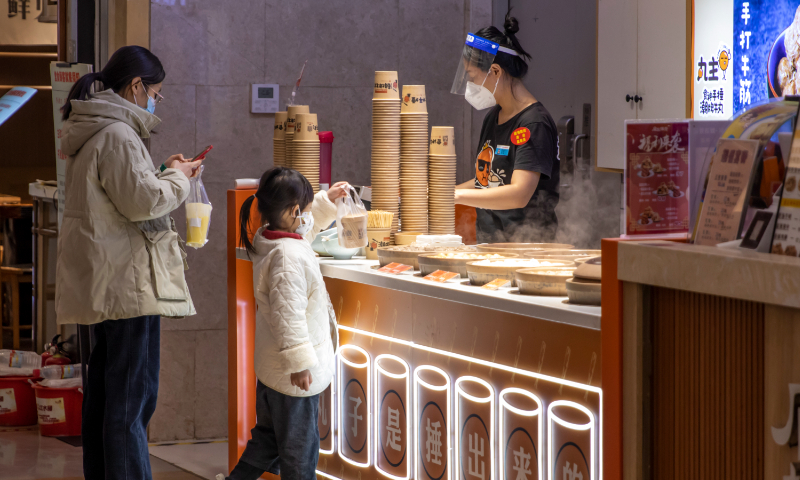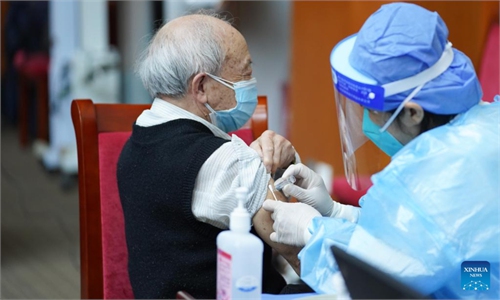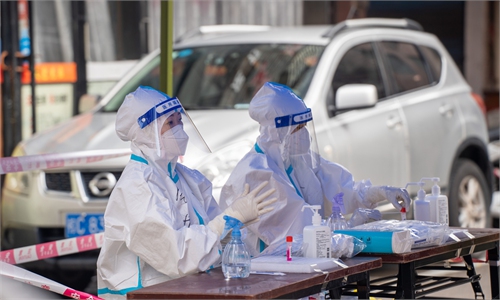Chinese cities implement newly issued measures to further optimize local response to COVID-19

People buy food at a takeaway counter in Zhengzhou, Central China's Henan Province on November 30, 2022. On the same day, the main urban area of Zhengzhou optimized epidemic prevention and control measures and resumed business activities in an orderly manner. Supermarkets, cinemas and subways reopened. Photo: VCG
Chinese cities continue to optimize their response to COVID-19 with many resuming business, removing testing requirements at transportation hubs from Thursday following the newly released 10 prevention and control measures by the State Council in light of the weakened virulence of Omicron.
China's National Health Commission on Thursday released guidelines for COVID-19 infections, providing detailed guidance on procedures for home quarantine, while many places including Beijing, Shanghai, Chongqing and North China's Hebei Province move to implement the central government's new measures.
Hebei on Thursday released measures to ensure daily life could return to normal in a managed fashion. In Shijiazhuang, capital of Hebei, dine-in services and other businesses including cinemas, libraries, museums, indoor stadiums and indoor swimming pools have resumed operations from Thursday.
Large-scale public activities such as performances, sports events, exhibitions and other activities can be held in a safe and orderly manner, according to Shijiazhuang officials. But for those vulnerable groups such as those in nursing homes and children in welfare institutions, closed-loop management will still apply. Most of the students in the city will continue with online classes, while third-year senior high school students will resume on-site classes starting from December 12, with a closed-loop management in place, authorities announced.
Beijing authorities issued 10 optimized measures on Wednesday night including taking a more nuanced approached to categorizing high-risk areas, removing restrictions for high risk regions in a timely manner, and allowing asymptomatic carriers, mild cases who meet requirements to quarantine at home.
On Wednesday, Shanghai released optimized COVID rules for travelers and close contacts. Testing requirements have been scrapped for arrivals in the city, including requiring three daily tests. Travelers without necessary testing will no longer be subject to a yellow health code, local officials said.
Close contacts who meet quarantine requirements can undergo a five-day home quarantine rather than a five-day centralized quarantine plus three-day home quarantine, officials confirmed.
China's Ministry of Transport on Wednesday released guidelines on COVID-19 prevention measures, removing the requirements for the checking of negative tests and health codes for cross-regional travelers, according to the ministry. The requirements for controlling the passenger load rate in low-risk areas have been fully removed.
Under the new guidance, a total of 333 expressway toll-gate exits in Southwest China's Chongqing Municipality have been opened, Chongqing authorities confirmed on Thursday. The total daily vehicle flow across the city reached 667,900 vehicles per day on Tuesday, up 185 percent compared with the average daily vehicle flow between November 13 and December 1. Traffic flows have recovered to 81 percent of the average daily level recorded in September, according to statistics.
Chongqing has reduced the COVID-19 prevention check points along expressway entrances to 31 and will no longer check 72-hour negative reports.
Chengdu Tianfu International Airport and Chengdu Shuangliu International Airport have both removed nucleic acid testing requirements for arriving passengers; while passengers no longer need to present negative test reports, health codes, information related to travel history, according to new local guidelines.
Other regions including Lüliang in North China's Shanxi Province and Wufeng county in Central China's Hubei Province have removed the check points to ensure the smooth flow of goods and people.
A total of 4,468 passenger trains ran on Wednesday, carrying 2.64 million passengers, passenger departures are expected to increase further with 4,609 passenger trains scheduled to operate on Thursday, China's state railway operator said. The operator has removed negative nucleic acid testing result and health codes requirements as part of pre-boarding checks.
At Beijing's Fengtai station, passengers no longer need to scan a health code and present 48-hour negative test results before entering the station. Passengers can enter by simply scanning their identity cards, according to China Central Television.


